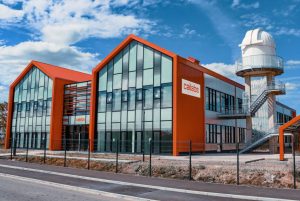Civilian Line-of-Sight Laser Communication

TILBA®-LOS optical terminals enable ultra-high-speed line-of-sight laser communications networks
In today’s landscape, the majority of data exchange relies on terrestrial networks. Nearly 99% of all communications are transmitted over optical fiber, while radio frequency and microwave signals cover the remaining fraction. However, these means of communication are limited in terms of accessibility, security and resilience. Line-of-sight optical communication emerges as a robust solution to overcome the inherent challenges of traditional terrestrial communication networks.
Ground-to-ground optical communication is a wireless data transmission method based on the propagation of light in vacuum and air. It employs optical terminals (transmitters and receivers) to transmit a signal from point A to point B, including via intermediate terminals. These terminals are equipped with optical systems that transmit, receive and relay the signal. Precise alignment between the terminals is crucial for optimal communication performance. However, these installations offer remarkable flexibility, allowing terminals to be positioned in diverse locations, such as atop buildings or suspended from vertical structures.
Also known as Free Space Optics (FSO), or free space laser communications, this technology emerged in the 1990s and has been used ever since as an effective alternative to conventional data transmission methods. It is used in a variety of applications, including telecommunications and secure data transfer. FSO technology is also particularly suitable for deploying local and temporary networks.
Different civilian LOS applications:
Dedicated networks
Line-of-Sight (LOS) optical links offer an ideal solution for establishing high-throughput communications between buildings within a business park, industrial site, university campus, or government complex. By utilizing optical terminals, LOS technology facilitates connectivity between buildings either by creating a dedicated network or expanding an existing one, without causing disruptions from extensive cable installations.
Last mile connectivity
In urban areas, optical transceivers can easily bridge the last-mile gap between telecom infrastructure and unconnected end-users without requiring the complex deployment of fiber optic infrastructure.
Accessibility
Ground-to-ground optical links present an efficient means to connect remote or hard-to-reach areas where there is no existing telecom infrastructure and deployment is not feasible. By leveraging optical communication, isolated users in rural communities, islands or even remote operations such as offshore platforms and wind turbines can gain access to essential services like telephone, internet and television networks.
Data centers
LOS links can be used to accelerate and ensure secure data transfer between data centers, while also serving as a backup solution for existing networks. Free-space optics technology is capable of meeting stringent data center requirements, enabling secure, high-throughput low-latency data transfer, efficient data replication, and robust backup and recovery solutions. This technology can also be used to link geographically dispersed data centers more efficiently, and as a back-up network for fast disaster recovery.
Disaster recovery
In disaster areas where the communication infrastructure has been damaged or destroyed, FSO can be used as an emergency communications solution. Deploying optical links enables communication to be re-established rapidly, facilitating response efforts, and ensuring vital connectivity during critical situations.
Temporary deployments
LOS links are also well-suited for temporary connectivity requirements, such as those encountered in events or construction sites. Their flexibility allows for rapid installation and dismantling without the need for permanent infrastructure. These links provide reliable and adaptative connectivity for temporary sites, making it easy to set up communications systems that meet the specific needs of each event or project.
In today’s communication landscape, ground-based networks encompass an array of technologies, each serving distinct connectivity needs. Fiber optics remain the preferred and cost-effective medium for long-distance, high-throughput communications, while copper networks cater to local internet and telecom services. Additionally, cellular networks offer expansive 4G LTE and 5G coverage, radio communication supports specialized wireless systems, power line communication enables data transmission through existing power grids, and microwave links establish vital point-to-point connections where physical cabling presents challenges.
While fiber optics excel in providing reliable long-distance connectivity, deploying fiber optic cabling can be complex or even impossible in certain scenarios. As a result, it becomes crucial to identify alternative solutions that meet specific requirements. However, today’s alternative methods also have some limitations. Most ground-based communication solutions rely on existing infrastructures, which are costly and complex to deploy or extend to unconnected areas.
Radio frequency (RF), historically employed for wireless communication, faces susceptibility to electromagnetic interference and necessitates licenses to operate within designated frequency bands. Due to the limited number available, licenses are particularly difficult to obtain, especially for new entrants facing heightened competition from the rapid expansion of 5G networks. Furthermore, existing networks struggle to keep pace with the escalating demand for secure, high-throughput, and low-latency data transfer-a critical necessity for various applications in today’s data-driven world.
Line-of-sight laser communication represents a reliable point-to-point solution, effectively addressing the increasing demand for high-throughput, low-latency, flexible and secure networks.
Line-of-sight laser solutions offer significant advantages and additional capabilities over conventional wired and wireless technologies as an alternative to fiber optics. They offer higher bandwidth capacity, enhanced security, and direct point-to-point connectivity. Laser communications are jam proof, immune to electromagnetic interference, can be deployed quickly and require minimal infrastructure. They have low latency and are ideal for real-time applications. Moreover, the compatibility of laser solutions with ultra-high capacity ground-based telecom technologies (up to several Tbit/s) make it possible to benefit from the technological maturity of the telecom industry.
However, laser communications have historically faced an important challenge: atmospheric turbulence. In fact, disturbances caused by the heterogeneity and constant movement of air can affect the phase and intensity of the light beam, degrading the quality of the link as it passes through the earth’s atmosphere. For LOS communications this implies a possible decrease in throughput, range, and signal availability. Nonetheless, a number of solutions exist to manage atmospheric disturbances.
Based on its Multi-Plane Light Conversion (MPLC) technology, Cailabs has developed an optical terminal capable of preserving the integrity of your transmissions by mitigating atmospheric turbulence .
Our TILBA®-LOS optical terminals, dedicated to ground-to-ground communications, enable the establishment of high-throughput, low-latency line-of-sight communication networks over distances exceeding 10 km by:
- Point-to-point optical communication links at 10 Gbps and higher
- Increasing the range and robustness of laser communications in the presence of atmospheric turbulence thanks to TILBA®-IBC, an incoherent combination technology integrated into the core of the optical terminal.
Cailabs has successfully established ground-to-ground laser communication links through the atmosphere, covering over 1 km in an urban environment. With data throughput rate of 10Gbps. This achievement was made possible thanks to our incoherent combination technology, TILBA®-IBC. Building on this success, we are currently working to demonstrate a space-to-ground link.




